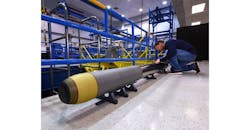Responding to the U.S. Navy’s Compact Rapid Attack Weapon program, Northrop Grumman has manufactured and tested an innovative very-lightweight torpedo (VLWT) to improve upon an undersea weapon with a heritage dating from World War II. The prototype torpedo is based on a design distributed by Pennsylvania State University’s Applied Research Laboratory (PSU-ARL) to industrial defense systems manufacturers in 2016; Northrop Grumman independently funded the research and development of the VLWT.
Northrop Grumman began working with torpedoes as Westinghouse, with the development of the MK18 electric torpedo based on a captured German electric torpedo. The company has contributed to significant advances in the underseas weapons technology with its MK48 Common Broadband Advanced Sonar System (CBASS) heavyweight torpedo and its MK50 Lightweight Torpedo. The firm is in full production of various torpedo arrays and has delivered more than 70 MK48 torpedo arrays to the Navy.
As part of developing a practical VLWT torpedo design, the company replaced as many high-cost components in the baseline system configuration as possible. Sections of the torpedo that were redesigned were built and tested with PSU-ARL’s test equipment to ensure confidence in the final design. David Portner, lead torpedo program manager of undersea systems for Northrop Grumman, noted: “The successful testing of the torpedo nose on the first try is a testament to Northrop Grumman’s design-for-affordability approach, which will significantly reduce cost without sacrificing operational performance.” The prototype VLWT was assembled with a stored chemical-energy propulsion system (SCEPS) manufactured by teammate Barber-Nichols.
“The nation needs advanced undersea warfare capabilities now more than ever,” said Alan Lytle, vice-president of underseas systems for Northrop Grumman. “We are ready to support fielding the VLWT, which will increase subsea lethality and enable innovative concepts of operations for multiple warfighting platforms,” he added.
About the Author
Jack Browne
Technical Contributor
Jack Browne, Technical Contributor, has worked in technical publishing for over 30 years. He managed the content and production of three technical journals while at the American Institute of Physics, including Medical Physics and the Journal of Vacuum Science & Technology. He has been a Publisher and Editor for Penton Media, started the firm’s Wireless Symposium & Exhibition trade show in 1993, and currently serves as Technical Contributor for that company's Microwaves & RF magazine. Browne, who holds a BS in Mathematics from City College of New York and BA degrees in English and Philosophy from Fordham University, is a member of the IEEE.
